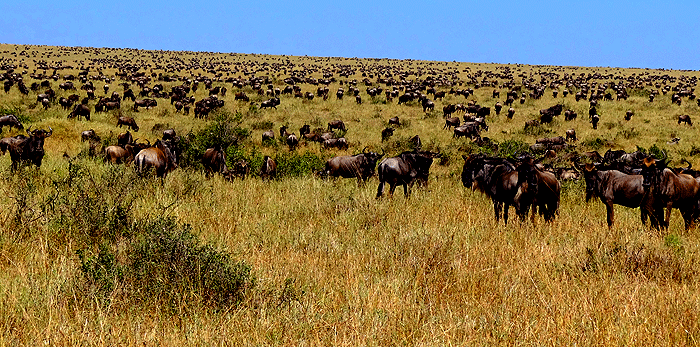A million wildebeest migration each one driven by the same ancient rhythm, fulfilling its instinctive role in the inescapable cycle of life: a frenzied three-week bout of territorial conquests and mating; survival of the fittest as 40km (25 mile) long columns plunge through crocodile-infested waters on the annual exodus, north, replenishing the species in brief population explosion that produces more than 8,000 calves daily before the 1,000 km (600 mile) pilgrimage begin again.

Tanzaniaís oldest and most popular national park, also a world heritage site and recently proclaimed a 7th worldwide wonder, the Serengeti is famed for its annual migration, when some six million hooves pound the open plans, as more than 200,000 zebra and 300,000 Thomsonís gazelle join the wildebeestís trek for fresh grazing. Yet even when the migration is quiet, the Serengeti offers arguably the most scintillating game-viewing in Africa: great herds of buffalo, smaller groups of elephant and giraffe, and thousands upon thousands of eland, topi, kongoni, impala and Grantís gazelle.
The spectacle predator versus prey dominated Tanzaniaís greatest park. Golden-maned lion prides feast on the abundance of plain grazers. Solitary leopards haunt the acacia trees lining the Seronera River while high density of cheetahs prowls the southeastern plains. Almost uniquely, all three African jackal species occur here, alongside the spotted hyena and a host of more elusive small predators, ranging from the insectivorous aardwolf to the beautiful serval cat.
But there is more to Serengeti than large mammals. Gaudy agama lizards and rock hyraxes scuffle around the surfaces of the parkís isolated granite kopjes. A full 100 varieties of dung beetle have been recorded, as have 500-plus bird species, ranging from the outsized ostrich and bizarre secretary bird of the open grassland, to the black eagles that sour effortlessly above the Lobo Hills.
As enduring as the game-viewing is the liberating sense of space that characterizes the Serengeti plains, stretching across sun burnt savannah to a shimmering golden horizon at the end of the earth.
Yet, after the rains, this golden expanse of grass is transformed into an endless green carpet flecked with wildflowers. And there are also wooded hills and towering termite mounds, rivers lined with fig trees and acacia woodland stained orange by dust.
Popular the Serengeti might be, but it remains so vast that you may be the only human audience when a pride of lions masterminds a siege, focused unswervingly on its next meal.
About Serengeti
Size: 14,763 sq km (5,700 sq miles) Location 335km (208 miles) from Arusha, stretching north to Kenya and bordering Lake Victoria to the west.
Getting there
Scheduled and charter flights from Arusha, Lake Manyara and Mwanza.
Drive from Arusha, Lake Manyara, Tarangire or Ngorongoro Crater.
What to do
Hot air balloon safaris, walking safari, picnicking, game drives, bush lunch/dinner can be arranged with hotels/tour operators. Maasai rock paintings and musical rocks.
Visit neighbouring Ngorongoro Crater, Olduvai Gorge, Ol Doinyo Lengai volcano and Lake Natronís flamingos.
When to go.
To follow the wildebeest migration, December-July. To see predators, June-October.
Accommodation Four safari lodges, several luxury tented camps and budget camp sites scattered through the park; one new lodge will be opened next season (Bilila Lodge); one luxury camp, a lodge and two tented camps just outside.
|





